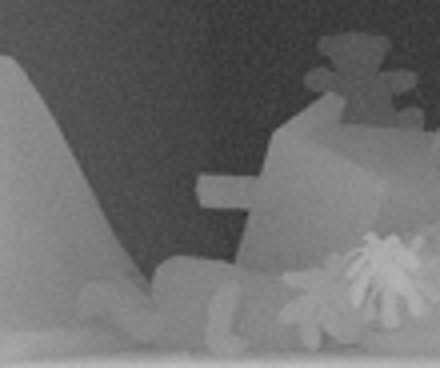Paddle-DSR-Lab is a toolkit for depth map super-resolution based on PaddlePaddle, a member of the PaddleDepth project. It is scalable and easy to use, and in addition it provides a fair comparison of algorithms in the field of deep graph super-resolution and SOTA (state-of-the-art) in image super-resolution with the same dataset and environment, in a training configuration consistent with the original paper.
| cones | tskuba | teddy | venus |
|---|---|---|---|
 |
 |
 |
 |
As initial version, we support the following algoirthms. We are working on more algorithms. Of course, you are welcome to add your algorithms here.
- WAFP-Net (IEEE Transactions on Multimedia 2021)[1]
- PMBANet (IEEE Transactions on Image Processing 2019)[2]
- RCAN (ECCV 2018)[3]
- DRN (CVPR 2020)[4]
You can install the Paddle-DSR-Lab toolbox by following these steps:
-
- Version requirements: PaddlePaddle>=2.3.0, Python>=3.7
-
Paddle-DSR-Lab is installed with the following command
git clone https://github.com/kongdebug/Paddle-DSR-Lab.git
cd Paddle-DSR-Lab
pip install -r requirements.txt
see guidance in dataset_prepare for dataset preparation.
python -u tools/main.py --config-file $file_path$- The
config-fileparameter is the path to the configuration file for the training model - If there are pre-trained weights for finetune, run the following command to start training, with the
loadparameter being the path to the pre-trained weights
python -u tools/main.py --config-file $file_path$ --load $weight_path$- If training is interrupted and needs to be resumed, run the following command, with the
resumeparameter as the checkpoint path
python -u tools/main.py --config-file $file_path$ --resume $checkpoint_path$python -u tools/main.py --config-file $file_path$ --evaluate-only --load $weight_path$The file structure of Paddle-DSR-Lab is shown below:
Paddle-DSR-Lab
│ README.md
│ README_cn.md
│ requirements.txt
├─configs
├─data
│ ├─process_DocumentIMG
│ ├─process_pmba
│ └─process_wafp
├─docs
├─ppdsr
│ ├─datasets
│ │ └─preprocess
│ ├─engine
│ ├─metrics
│ ├─models
│ │ ├─backbones
│ │ ├─criterions
│ │ └─generators
│ ├─modules
│ ├─solver
│ └─utils
└─tools You can develop your own algorithm by following these steps:
- Check if your model needs a new loss function for training, and if so add the loss function to
ppdsr/models/criterions. - Check if you need to add new models for training, if so add them to
ppdsr/models. - check if you need to add new datasets for training, and if so add the datasets to
ppdsr/datasets - Add your own configuration file (.yaml) to
configs
We evaluated the algorithms already implemented in Paddle-DSR-Lab using the four depth maps teddy, cones, tskuba and venus as a test set DSR-TestData.
Note: We did not optimize the model results by additional tricks, so you can directly use the .yaml configuration file to reproduce the accuracy we report in the table.
| Model | PSNR | SSIM | RMSE | MAD | size |
|---|---|---|---|---|---|
| WAFP-Net [1] | 42.0344 | 0.9834 | 2.5561 | 0.9246 | 3M |
| PMBANet [2] | 41.0418 | 0.9825 | 2.4728 | 0.6278 | 94.9M |
| RCAN [3] | 42.5297 | 0.9850 | 2.4401 | 0.6685 | 59.6M |
| DRN [4] | 42.4906 | 0.9850 | 2.4634 | 0.6506 | 18.4M |
The toolkit is under active development and contributions are welcome! Feel free to submit issues or emails to ask questions or contribute your code. If you would like to implement new features, please submit a issue or emails to discuss with us first.
[1] Song, Xibin, Dingfu Zhou, Wei Li, Yuchao Dai, Liu Liu, Hongdong Li, Ruigang Yang, and Liangjun Zhang. ‘WAFP-Net: Weighted Attention Fusion Based Progressive Residual Learning for Depth Map Super-Resolution’. IEEE Transactions on Multimedia 24 (2022): 4113–27. https://doi.org/10.1109/TMM.2021.3118282. .
[2] Ye, Xinchen, Baoli Sun, Zhihui Wang, Jingyu Yang, Rui Xu, Haojie Li, and Baopu Li. ‘PMBANet: Progressive Multi-Branch Aggregation Network for Scene Depth Super-Resolution’. IEEE Transactions on Image Processing 29 (2020): 7427–42. https://doi.org/10.1109/TIP.2020.3002664.
[3] Zhang, Yulun, Kunpeng Li, Kai Li, Lichen Wang, Bineng Zhong, and Yun Fu. ‘Image Super-Resolution Using Very Deep Residual Channel Attention Networks’. In Computer Vision – ECCV 2018, edited by Vittorio Ferrari, Martial Hebert, Cristian Sminchisescu, and Yair Weiss, 11211:294–310. Lecture Notes in Computer Science. Cham: Springer International Publishing, 2018. https://doi.org/10.1007/978-3-030-01234-2_18.
[4] Guo, Yong, Jian Chen, Jingdong Wang, Qi Chen, Jiezhang Cao, Zeshuai Deng, Yanwu Xu, and Mingkui Tan. ‘Closed-Loop Matters: Dual Regression Networks for Single Image Super-Resolution’. In 2020 IEEE/CVF Conference on Computer Vision and Pattern Recognition (CVPR), 5406–15. Seattle, WA, USA: IEEE, 2020. https://doi.org/10.1109/CVPR42600.2020.00545.